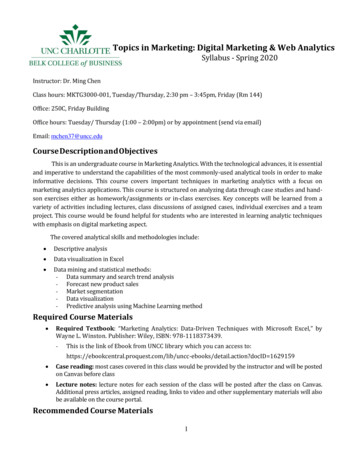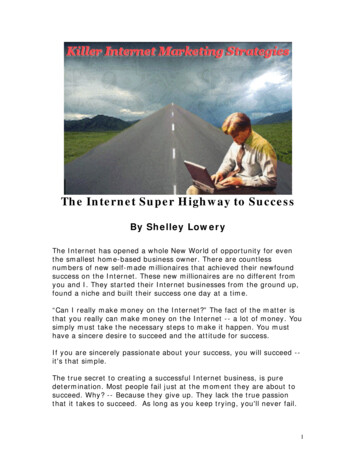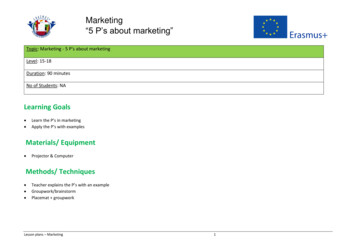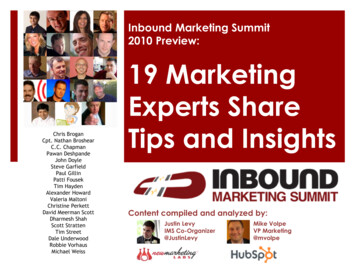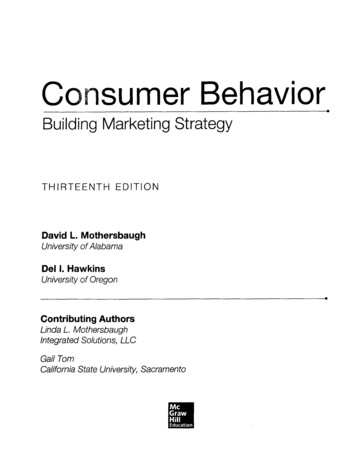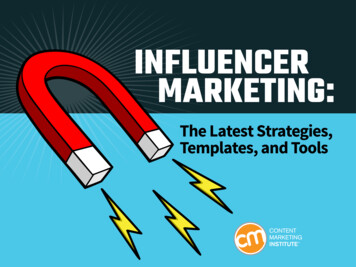
Transcription
INFLUENCERMARKETING:The Latest Strategies,Templates, and Tools1
You’ve come to the right place.We’ve gathered some of the smartest practicesin the industry to help increase yourunderstanding of the technique, and enable youto use it to amplify the impact of your content.Looking to build,or expand, aninfluencer programas part of your contentmarketing strategy?We’ve also supplied some handy advice, process guides,and templates that will make it easier to plan and executeyour program while keeping your efforts on track with your goals.Read on for everything you’ll need to make influencer marketing a successful componentof content marketing in your organization.1
1JUSTIFY INFLUENCER MARKETINGInfluencer marketing programs rely on the strong voices in your industry – in other words, people who already have the ear of your target audienceand are willing to help bring your business to their attention. Their level of participation can be something simple, like regularly re-tweeting yourcontent to their communities, or as proactively involved as co-producing content for collaborative publication.Why do you want to go to the trouble of working with influencers? They have a pre-established audience that is already receptive to their ideas andrecommendations. This means they are well positioned to amplify reach and awareness, which, in turn, helps your content get found and consumedby the right audience.They can also lend credibility to a particular piece of content, as their endorsement trades on the trust they have earned, over time, from theirfollowers. In addition, companies can piggyback on an influencer’s favorable brand reputation to develop the rapport necessary to reach and buildtrust among the right audiences.Make the case in your organizationCompanies often find it challenging just to get the necessary buy-in and budget for content marketing, let alone for a promotional add-on. So how canyou convince your stakeholders that it’s important to add influencers into your content mix? Here are just a few facts you can cite as compelling evidenceof its value: It builds trust: 92% of people trust recommendations from individuals (even if they don’t know them) over brands. It attracts qualified leads: According to a Tomoson poll, 51% of marketers believe they get better customers from influencer marketing. 2 our competitors are getting good results with it: A May 2015 study found that 84% of global marketers expected to launch at least oneYinfluencer marketing campaign in the coming years, and 81% of those who had already done so reported they were happy with the results.I t increases ROI: According to a Burst Media study analyzed by eMarketer, brands saw an average ROI of 6.85 for every dollar invested ininfluencer marketing.
2IDENTIFY YOUR GOALSDetermining the best ways to work with influencers starts by identifying – and documenting – the specific business goals you want your effortsto accomplish.Here are a few potential objectives you can use to help build your own list of goals, along with the signs of influencer success you’ll need to be awareof for each one: 3B rand awareness: How many people viewed, downloaded, or listened to this piece of contentbecause of the influencer?Engagement: How often is your content shared with others because of the influencer?A udience building: How is the influencer helping to convert peopleinto subscribers and valuable leads?L ead nurturing: Does interaction with the influencer help movea lead closer to a sale?S ales: Did you make money because of this content shared bythe influencer? What revenue or ROI can you apply to this program?C ustomer retention/loyalty: How can an influencer help retain a customer?U psell / cross-sell: Is there a way to use an influencer to help someonebecome more invested in your business?
3FIND YOUR IDEAL INFLUENCERSInfluencers can be instrumental to optimizing the impact of your content marketing, and knowingwhat you want that success to look like is an important first step toward achieving it. But you willalso need to find reliable partners to power your influencer engine, and that’s not always easy. Infact, as Andrea Lehr recently pointed out, a whopping 75% of marketers consider finding theright influencers to be the most challenging aspect of this outreach strategy.Depending on your goals, you may not necessarily have to impress a big-name industry “guru” orentice an internet celebrity to take up your cause (though both are viable options). But how doyou find the most trustworthy partners among the sea of influential industry players out there?KNOW YOURPREFERRED “TYPE”It helps to start by determiningthe types of influencers that youshould be looking to work with. Forexample, here are a few commoncategories: Like most other facets of influencer marketing, your specific content objectives will helpdetermine which relationships will be worthy of pursuing. For example: I f your aim is greater awareness and/or reach, you may choose to work with popularbloggers or social media influencers who can help increase your share of voice across theplatforms where each is most active. 4I f you are looking to retain customers or upsell, current customers often make more of animpact on decision-making than a neutral third party.BloggersCustomersMembers of a purchasing group Industry experts, analysts, andthought leadersBusiness partners Internal subject-matterexperts Celebrity tastemakers andtrendsetters
Where to lookOnce you’ve decided on the types of influencers you want to leverage, you will need to findviable candidates.Through your regular networking and social media activities, you are likely already aware of somehigh-profile professionals you might want to partner with. But it’s always a good idea to add arange of expertise to your influencer pool – especially when you are just starting out – since younever know when a preferred influencer might be unavailable, unreachable, or have conflictinginterests or obligations that would make them a poor fit for your needs.One way to find worthy partners is to ask around. Attend events in different areas of your businessand survey attendees, talk to your customers and your sales team members to see who theyfollow, ask other colleagues for recommendations, or get involved in relevant social mediaforums and discussion groups and ask (or just observe) who the main players are.Another way to approach influencer discovery is to use keyword-based searches to uncovernotable names that pop up in relation to your chosen topic.In his recent post, Aaron Agius shares the search-based process he uses to find great placementsfor his content, which can be easily adapted to uncover influential voices to connect with:STEP 1: Use Google to find relevant sites: Search for [your industry] “blog” (or “site”).Then, use advanced search operators to expand or narrow your results, as needed.Consider adding the top resources to your list; but bear in mind that it may be tough to getthe attention of the experts running those sites, as they are likely to get a lot more inquiriesthan sites that are a bit further down the list.5REMEMBER:As you discover potentialpromotional partners,you will want to listen in on theirinsights and content activities ona regular basis. Once you are readyto ask them for their participation,you’ll have a much easier timegetting their attention if youare familiar with the topics theyfrequently cover (and the positionsthey typically take on thosetopics), or have already engagedin conversations with them intheir chosen forums. This meanssubscribing to their newsletters;reading their blogs; following themon Twitter, Google , or LinkedIn;and seeking out the other contentchannels where they frequentlyshare their thoughts and ideas.
STEP 2: Qualify sites: To decide if a potential influencer is worth adding to your outreachlist, look for evidence of qualifying criteria on the sites that popped up on your SERP, such as: D omain authority: How well does the influencer’s site rank on search engines?S ocial reach: How large is their following on social platforms?S haring habits: How often does the influencer share others’ content, as opposed totheir own original material?Don’t forget to follow your instincts: If you visit the influencer’s site and it just doesn’t look or feellike it would be a good fit for your brand’s content, it’s best to leave them off the list – you canalways add them back if you discover mitigating circumstances.STEP 3: Find the correct contact details: Ideally, you will want your request forparticipation to go through the proper channels, but sending an email to an anonymous“Info@” address or blindly submitting a contact form may not be enough to get your messagein front of the influencer him or herself. Instead, try reaching out to your network to see if youhave mutual acquaintances, or search the influencer’s social profiles to see if you can turn upa direct email address.6HANDY TIP:As Devesh Khanalreminds us, searchfor influencers with highengagement levels – not justhigh follower counts – as thesecan be artificially inflated andmay not represent true thoughtleadership. Look for signs – liketheir participation in discussiongroups, the number of commentsthey receive on their content,and how often they respondto those comments – to gaugehow active and engaged in theircommunities they truly are.
4PREPARE YOUR OUTREACHInfluencer agreements can take many forms, depending on variables like: W ho the influencer isT he specific content types and platforms you want their help withT he level of involvement you are expectingW hat you are offering them in return for their effortsBut regardless of how you end up structuring your arrangement, the initial outreach is fairlyuniversal: You need to contact potential partners, and deliver a prepared pitch that will compelthem to say yes to your requests.Any efforts you’ve already undertaken to track down influencer contact information and preferredmedia channels will come in handy at this stage, as your next step is to initiate contact.Making the first “connection”There are multiple ways you can establish contact with your target influencers, including: G iving them some positive attention through a reply, re-tweet, or mention on the socialchannels they frequentP roviding thoughtful comments on their blog postsC onnecting with them on LinkedIn, introducing yourself, and explaining why you’d like toconnectM aking an old-school phone callWhile these are all acceptable approaches, perhaps the most direct and successful way to reachout to an influencer is via email.7HANDY TIP:The key to successfuloutreach is not toseem like you’re asking for afavor; rather, try suggestinga collaboration that takesinto account their skills andinterests first, putting your needssecondary.
Ideal outreach: EmailOf course, you can’t just send a link to your content in an email and expect the influencer to begyou to get involved. You need to do everything you can to ensure that your target opens youremail and becomes interested in working with you.What key characteristics make for a great outreach email? Here are a few guidelines Aaron Agiusshared in his aforementioned post: 8I t should have an honest, yet enticing headline: Influencer relationships are mostsuccessful when they are founded on mutual trust and respect. That will be hard to establishif your email has a misleading headline or other deception that tricks the influencer intoreading it.I t should be brief: You’ll generally be contacting busy people who don’t always have timeto read all the emails they receive. Be sensitive to their time constraints by getting to thepoint quickly and concisely.I t should be personalized: Be upfront and direct about why you think they, personally,should care about your content and want to get involved. But make sure you are genuine inyour praise – false flattery tends to stand out like a sore thumb.It should explain what you want them to do: Plainly and politely outline what youwould like their involvement to entail, and how flexible you are on the terms you areproposing. If you decide to gothe email route,Amanda Maksymiw hasshared some fantastic templatesyou can customize to make youroutreach efforts more efficient.Here’s one example below:
Outreach suggestionsNot sure what, specifically, to ask influencers to do on your content’s behalf? Here are some suggestions, which range from one-time contributionsto ongoing partnerships: A sk for a quote for an upcoming article, blog post, e-book, or other effort. A sk them to participate in an interview. R equest that they speak at a conference you are involved in organizing. R equest their participation in a crowdsourced article. S eek their permission to share, link to, or republish their content on your blog. R equest information or data for a case study. A sk them to write a guest blog post, or feature in one. I nclude them in an expert panel at an industry event. I nvite them to be a guest on a podcast, Twitter chat, or webinar you are hosting.Tracking your outreachAs you conduct your outreach, you will wantto track your efforts, so you know who you’vecontacted, who has agreed to participate,and what terms they’ve agreed to. Here is asample template you can downloadand customize to help get you started(Go to “File Download As ” and selectthe format you would like).9
5SEED YOUR INFLUENCERS’ EFFORTSIn many instances, after you’ve made connections with your targeted influencers, you’ll havean opportunity for influencers to share your content. This means you need to create somethingthat they will be proud to put their personal brand behind.Not every piece of content you create will be right for every influencer. To determine whether ornot it’s a fit, consider your answers to questions like these:10 I s it relevant to your influencer’s areas of expertise and passion? W ill it
STEP 2: Qualify sites: To decide if a potential influencer is worth adding to your outreach list, look for evidence of qualifying criteria on the sites that popped up





